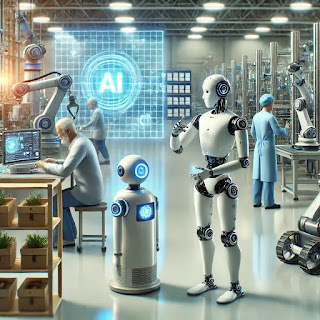AI for Advanced Robotics: From Factory Automation to Humanoid Assistants
Introduction
Artificial Intelligence (AI) is rapidly transforming the field of robotics, enabling machines to perform complex tasks with greater efficiency and autonomy. From assembly line automation in factories to humanoid assistants capable of interacting with humans, AI-driven robotics is reshaping industries and everyday life. In this blog, we explore how AI enhances robotic capabilities, the key technologies behind these advancements, and the future of AI-powered robots.
Meta Description
Discover how AI is revolutionizing robotics, from factory automation to humanoid assistants. Learn about key AI technologies driving advanced robotics and their future impact on industries and daily life.
AI in Factory Automation
Enhancing Manufacturing Efficiency
One of the most significant applications of AI in robotics is in manufacturing automation. AI-powered robotic arms and automated guided vehicles (AGVs) are streamlining production lines, increasing efficiency, and reducing costs. Machine learning algorithms help these robots optimize workflows, predict maintenance needs, and improve quality control.
Predictive Maintenance
AI-driven predictive maintenance allows robotic systems to anticipate potential failures before they occur, minimizing downtime and operational disruptions. By analyzing data from sensors and historical performance, AI can help factory robots self-diagnose issues and request maintenance in real-time.
Quality Control with Computer Vision
Computer vision, powered by AI, enables robots to detect defects, inspect products, and ensure high-quality standards in manufacturing. These AI-enhanced vision systems analyze images at high speeds, providing real-time insights that improve quality assurance processes.
Humanoid Assistants and AI
Advancements in Human-Robot Interaction
Humanoid robots, designed to assist humans in various tasks, are becoming increasingly sophisticated due to AI advancements. Natural language processing (NLP) allows them to understand and respond to human speech, while computer vision helps them recognize faces, gestures, and emotions. These capabilities enable robots to serve as customer service assistants, caregivers, and even companions.
AI in Healthcare Robotics
AI-powered humanoid robots are making significant strides in healthcare. They assist in elderly care, provide companionship, and help individuals with disabilities. Some robots are equipped with AI-driven diagnostic tools that aid doctors in monitoring patients’ health conditions.
Service and Hospitality Robotics
In the service and hospitality sectors, AI-driven humanoid robots are being deployed as receptionists, hotel concierges, and restaurant servers. They enhance customer experiences by providing personalized interactions and handling repetitive tasks efficiently.
Key Technologies Driving AI in Robotics
Machine Learning and Deep Learning
Machine learning, particularly deep learning, is at the core of modern robotics. Neural networks allow robots to learn from data, adapt to new situations, and improve performance over time.
Computer Vision
Computer vision enables robots to interpret and interact with their environment by recognizing objects, people, and patterns.
Reinforcement Learning
Reinforcement learning allows robots to learn from trial and error, improving their decision-making abilities through continuous feedback and optimization.
Edge AI and Cloud Computing
Edge AI enables real-time processing on robotic devices, reducing latency and improving responsiveness, while cloud computing supports data storage, analysis, and remote operation.
Conclusion
AI is revolutionizing robotics, making automation more intelligent, adaptable, and human-centric. From enhancing industrial manufacturing processes to creating lifelike humanoid assistants, AI-driven robotics is shaping the future of work, healthcare, and everyday interactions. As advancements continue, we can expect even more seamless integration of AI in robotics, leading to smarter and more efficient robotic solutions.
Join the Conversation
What are your thoughts on AI-powered robotics? Do you see humanoid robots becoming a part of daily life soon? Share your insights and opinions in the comments below!

Comments
Post a Comment